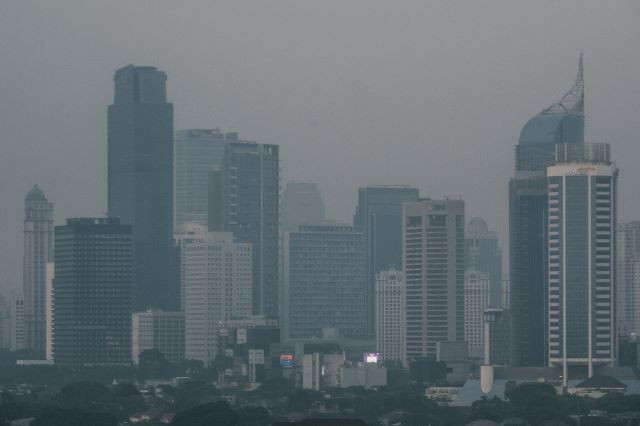Popular Reads
Top Results
Can't find what you're looking for?
View all search resultsPopular Reads
Top Results
Can't find what you're looking for?
View all search resultsThe fairy chimneys
Balloons ready to take off
Change text size
Gift Premium Articles
to Anyone

Balloons ready to take off. JP/Pandaya
A hot-air balloon sails across the moonscape of Cappadocia.
We shivered in the morning chill while rushing to a waiting bus outside the Dinler Hotel. Soon the bus was traversing the typically narrow streets of the hilly Cappadocia region in Central Anatolia, Turkey, which were still blanketed with a thin mist.
The landscape on both sides of the roads was unusual: Cave houses chiseled into rock hills that you would not find anywhere else. Breathtaking rock formations glowed in the clear dusk as the reddish light of the sun began to emanate on the horizon. 
When we reached a windy field on one of the hills, the captain of our balloon wasted no time and asked us to jump on board so that everybody could see the sunrise while flying.
“We’re taking off soon,” said the captain. “The highest altitude will be 700 meters above ground. We won’t be able to control the direction so we don’t know where we will land. We’re going with the wind,” he quipped, laughing.
As the balloon slowly lifted and the sun rose, the scene was overwhelmed with balloons, those preparing to fly and those already in the air. 
The bird-eye view from the balloon box, crammed by a dozen passengers, was just as stunning. Spreading out beneath us was the famed Monks Valley, or Pasabag in Turkish, which we had explored the day before.
The lunar landscape of the valley is renowned the world over for its fairy chimneys, or Peri Bacalan in Turkish, and spectacular rock formations formed through a process of erosion millions of years ago. 
According to folk tales, the formations were called “fairy chimneys” because early residents believed the place was home to fairies who lived underground. Different kinds of fairy chimneys can be found. Typically they are shaped like gigantic mushrooms. Some stand on broad bases and some are “headless”. All have been formed naturally.
Monks Valley allegedly received its name as monks took refuge there in the early period of Christianity around the 4th or 5th Century. If you arrive there by bus, you will be directed to tour the main section, which is said to be a one-time monastery, where all rooms have been carved out of rock: the chapel, the hermit shelter, living rooms, kitchens, libraries and cave houses.
Numerous documents mention Saint Simeon (or Simon) as one of the monks who took shelter and served the underground community. Tales have it that he moved to the monastery to avoid attention from people who believed he could perform miracles.
He lived in the upper cave of the 15-meter tall fairy chimneys and descended only occasionally to receive food from his disciples. Visitors can climb to St. Simeon’s hermitage and imagine life inside it almost 2,000 years ago.
Living in seclusion, hermits in the valley hollowed out the chimneys from the bottom up to create rooms that were 10 to 15 meters from the ground.
Like people nowadays the ancient residents grew wheat, grape and vegetables. They domesticated pigeons in their cave houses and used the animal’s droppings as fertilizer.
From inside the slow-moving balloon, visitors are able to see more of the majestic fairy chimneys in the glorious morning (unless the weather suddenly turns bad). A good captain knows how to glide low and bring you closer to the rock formations. You will not forget the stunning valleys and the vast vineyards below.
Cappadocia’s fairy chimneys and their prehistoric stories do not stop there. The ancient city that is mentioned in the biblical account given in the Book of Acts 2:9 is also home to many underground cities, where you can find traces of early Christianity.
So from the Monks Valley, off we went to the underground city of Kaymakli in Urgup, less than an hour’s drive away through country roads winding up and down through endless hills, which have become a favorite place for Turks to build their homes.
They say that people in the ice age preferred to live in the caves they chiseled in the soft tufa rock to survive the harsh weather.
The temperature inside the dwellings carved into the many hills and mountains in Cappadocia was said to be relatively stable, at about 16 degrees Celsius.
Strabon (84 BC-17AD), an ancient writer, described the underground dwellings in Cappadocia in his famous book Geography: “The houses in the villages were constructed under the ground. The entrances to the houses were very narrow, more like the mouth of a well. However, the rooms were pretty wide. The animals were also kept in the same rooms chiseled underground and there were special tunnels for them to get in and out. You would not know or see the entrances to these tunnels. But humans were using ladders to get into animals’ rooms. There were sheep, goats, poultry, cattle and their offspring.”
Once visitors step into the main entrance, they find themselves in a spacious room where residents used to keep their animals, especially cattle. The whole Kaymlaki complex cave dwelling could accommodate about 2,000 people.
The hundreds of rooms are connected with long, narrow tunnels or corridors. Often, you have to duck to pass through the dimly lit rooms. The ends of the tunnels are blocked with cylindrical bolt stones 1 to 1.5 meters in diameter, which weigh some 300 kilograms. They have a hole in the middle for the guard to look out of for incoming enemies and to launch attacks from with a lance or arrow.
Just like people in the current Internet age, those living in caves in the Ice Age built their own version of living rooms, chapels, chimneys, kitchens, tombs, winery and systems of defense.
I wondered how these ancient dwellings in the soft tufa rock could still exist today after thousands of years?
According to Jeoffrey Lamec in his book The Underground Cities of Cappadocia, tufa rock can be shaped very easily but can become very hard and strong thanks to a 6 centimeter-thick protective layer that is formed within 48 hours after the shaped rock is exposed to oxygen.
After visiting other hectic places in Turkey, Cappadocia offers a peaceful alternative with both natural rocks of wonder and historical traces of an early civilization.









